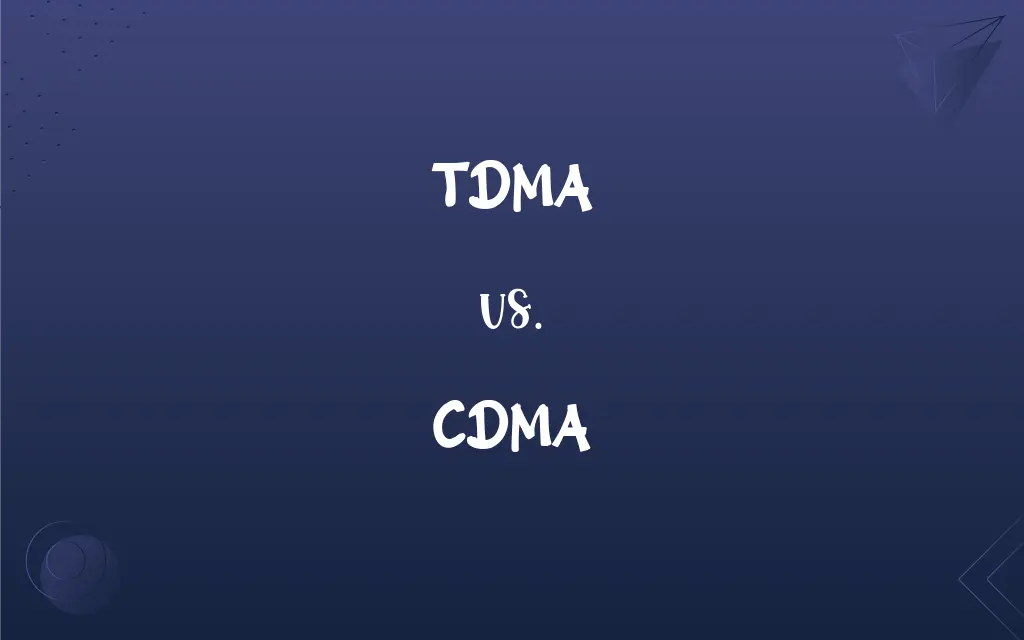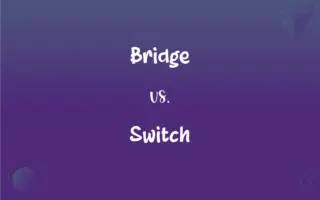TDMA vs. CDMA: What's the Difference?
Edited by Aimie Carlson || By Janet White || Published on February 12, 2024
TDMA (Time Division Multiple Access) allocates distinct time slots to each user in a channel, while CDMA (Code Division Multiple Access) allows multiple users to share the same frequency band simultaneously through unique codes.

Key Differences
TDMA, Time Division Multiple Access, is a technology that divides a single communication channel into multiple time slots, assigning each user a unique slot for transmission. CDMA, Code Division Multiple Access, employs spread-spectrum technology, allowing multiple users to use the same frequency simultaneously, differentiated by unique code sequences.
In TDMA, the communication channel is segmented into sequential time slots, with each user occupying a full channel for a fraction of time. This contrasts with CDMA, where each user's signal is encoded with a unique code and transmitted over the entire frequency spectrum all the time.
TDMA effectively manages the radio spectrum by allocating distinct time slots, reducing interference and maximizing channel efficiency. Conversely, CDMA uses a different approach, spreading each user's signal across a wide frequency band, using coding to distinguish between users.
A key characteristic of TDMA is its simpler technology and lower power consumption, making it ideal for earlier mobile systems. CDMA, however, offers higher capacity and better security due to its spread-spectrum technique, which is more complex and power-intensive.
TDMA systems are more prone to time synchronization issues, while CDMA systems can better handle simultaneous data and voice transmissions, offering advantages in 3G and beyond mobile technologies.
ADVERTISEMENT
Comparison Chart
Access Method
Time-based division
Code-based division
Channel Allocation
Distinct time slots per user
Shared frequency with unique codes
Capacity and Efficiency
Limited by time slot availability
Higher, due to spread-spectrum technology
Power Consumption
Generally lower
Higher due to continuous transmission
Suitability for Advanced Data
Less suitable for high-speed data
More suitable for high-speed data and 3G+
ADVERTISEMENT
TDMA and CDMA Definitions
TDMA
TDMA is commonly used in 2G cellular systems.
The early mobile phones operated effectively on TDMA technology.
CDMA
CDMA is a foundational technology for 3G cellular networks.
CDMA's ability to handle high-speed data made it preferable for 3G.
TDMA
TDMA is a communication technology that divides channels into time slots.
TDMA was widely used in the second generation of mobile networks.
CDMA
CDMA is a multiple access method used in telecommunications.
CDMA's spread-spectrum technology revolutionized mobile communication.
TDMA
TDMA allows multiple users to share the same frequency band sequentially.
TDMA enabled simultaneous calls by assigning distinct time slots.
CDMA
CDMA allows multiple users to share the same frequency band using unique codes.
CDMA increased capacity by encoding each user's signal differently.
TDMA
TDMA helps in reducing signal interference and improving bandwidth.
TDMA's structured time slots minimized cross-talk among users.
CDMA
CDMA provides better security and capacity compared to earlier technologies.
CDMA's encoding techniques significantly reduced the risk of eavesdropping.
TDMA
TDMA assigns individual time slots for each user in a network.
The network's efficiency improved with TDMA's time slot allocation.
CDMA
CDMA employs spread-spectrum technology for signal transmission.
The secure nature of CDMA made it ideal for military communications.
FAQs
Is TDMA suitable for high-speed data transmission?
TDMA is less suitable for high-speed data compared to CDMA.
What is CDMA?
CDMA is a communication method where multiple users share the same frequency band using unique codes.
What are the advantages of CDMA over TDMA?
CDMA offers higher capacity, better security, and is more suited for high-speed data.
How does TDMA allocate channel access?
TDMA allocates channel access by dividing time into sequential slots for each user.
Can TDMA and CDMA coexist in the same network?
In practice, they are generally used in separate networks due to their different operational mechanisms.
Is CDMA used in 4G networks?
4G networks primarily use technologies like LTE, which differ from traditional CDMA.
What makes CDMA different in terms of frequency use?
CDMA allows all users to transmit over the entire frequency spectrum simultaneously.
Can TDMA handle simultaneous voice and data transmissions effectively?
TDMA is less efficient in handling simultaneous voice and data compared to CDMA.
What is TDMA?
TDMA is a technology that divides a communication channel into time slots for multiple users.
Are new developments still being made in TDMA and CDMA?
Most modern developments are focused on newer technologies like LTE and 5G, moving away from traditional TDMA and CDMA.
What kind of synchronization is required for TDMA?
TDMA requires precise time synchronization to function effectively.
Which technology was first to be used in mobile communications?
TDMA was used earlier, particularly in 2G networks, before the advent of CDMA.
What is the primary application of CDMA?
CDMA is primarily used in mobile phone networks and for wireless data communications.
Does CDMA offer better network coverage?
CDMA can potentially offer better coverage and capacity, especially in densely populated areas.
Are there power consumption differences between TDMA and CDMA?
Yes, TDMA generally consumes less power compared to CDMA.
Is CDMA more secure than TDMA?
Yes, CDMA's unique coding for each user provides enhanced security.
How does TDMA affect call quality?
TDMA can lead to lower call quality due to its time-based division of channels.
What are the drawbacks of CDMA?
CDMA's drawbacks include complexity and higher power consumption.
Does CDMA require complex encoding and decoding?
Yes, CDMA requires complex encoding and decoding mechanisms for its operation.
Is TDMA still relevant in modern telecommunications?
TDMA has largely been superseded by newer technologies but is still relevant in certain legacy systems and applications.
About Author
Written by
Janet WhiteJanet White has been an esteemed writer and blogger for Difference Wiki. Holding a Master's degree in Science and Medical Journalism from the prestigious Boston University, she has consistently demonstrated her expertise and passion for her field. When she's not immersed in her work, Janet relishes her time exercising, delving into a good book, and cherishing moments with friends and family.
Edited by
Aimie CarlsonAimie Carlson, holding a master's degree in English literature, is a fervent English language enthusiast. She lends her writing talents to Difference Wiki, a prominent website that specializes in comparisons, offering readers insightful analyses that both captivate and inform.







































































